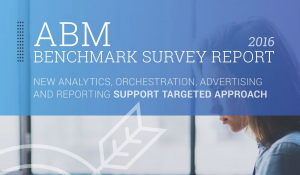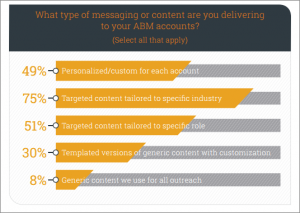
Account-based marketing.
For many of us in the B2B marketing space, this concept has been buzzing in our ears over the past couple years.
If you’re less familiar, ABM is a highly-strategic marketing approach that uses quality, relevant content to reach and nurture specific strategic accounts or individuals. Essentially, rather than casting a wide net to entangle thousands of prospects or current customers, ABM aims to spear the biggest, easiest or most relevant catches.
But ABM isn’t a new tactic. However, awareness and adoption is on the rise thanks in part to new technology options that help marketers target more accurately and scale ABM, according to Demand Gen Report’s ABM Benchmark Survey Report 2016. In fact, 47% of the marketers surveyed said they have an ABM strategy in place, with 33% reporting they plan to implement ABM in the next 18 months.
The new report, which was sponsored by EverString and DOMO, aimed to uncover insights on ABM adoption, tactics, and the challenges marketers are facing. Below we dive into some of those key insights and offer some advice for improving your ABM efforts or adding it to your marketing mix.
#1 – Sales and marketing alignment is critical to success.
It’s no secret that the relationship between sales and marketing departments can be a little tenuous. But it’s also no secret that when these two teams work together, magic can happen.
As TopRank Marketing’s Josh Nite recently wrote, “Sales and marketing should be BFFs. We might have different focuses and methodology, but the goal is the same for both departments: make sales and drive revenue.”
But where do you start? According to the report, 47% of marketers said one of their greatest challenges was sales and marketing alignment.
“Sales and marketing alignment is the cornerstone of successful, strategic ABM,” Jeffrey Sands, VP and Account-Based Marketing Practice Co-Lead at ITSMA, said in the report. “In order to best achieve this, you have to get the seniormost sales and marketing executives to both agree that ABM is important and that it is an important strategy moving forward.”
The bottom line? Start with getting buy-in from the top of both departments. If the department heads are on-board, it will trickle down to the rest of the team.
#2 – Personalization is key.
The whole point of ABM is to inform, engage and inspire action from a specific group of accounts or individuals, so it’s no wonder that a majority of marketers surveyed said they’re tailoring their content and outreach—just 8% said they use generic messaging. As you can see below, there are several different ways to approach this, but most are targeting by industry.

As for delivering that content, marketers said they use a mix of content offers and lead gen formats including: targeted executive events (66%), interactive content tailored by industry or role (62%) and direct mail (60%). Other tactics listed included email, social media, retargeting and account-based ads, webinars and surveys.
Ultimately, the best approach for you will depend on the team and technology you have in place, as well as the goals you’ve set.
#3 – Utilizing tech and tools are a must.
The ability to collect and analyze data has a direct impact on the success of your marketing efforts—and ABM is no different. According to the report, 92% of marketers use analytics and reporting tools to support their ABM strategy, with 59% of them saying these tools are critical.
In addition, 91% said they’re utilizing campaign execution and orchestration tools, with 61% saying these are critical tools. In addition, about two-thirds (64%) said they use account-based advertising tools and 49% are using predictive tools.
There are a number of different platforms and tools you can look into. Some include: Marketo, Engagio, EverString, Demandbase, and LeanData.
#4 – It matters how you measure success.
I think it’s safe to say that proving ROI is a focus and challenge for many marketers, regardless of the tactics you’re using, and it often comes down to making sure you’re tracking and measuring the right things.
Demand Gen Report’s survey found that those adopting ABM are are shifting away from traditional metrics like MQLs to focus on those that are more revenue-focused. For example, 59% of marketers surveyed said they track pipeline velocity.
“A lot of ABM is based on marketing to existing customers, so pipeline contribution and net-new accounts are actually bad measures—but many marketers have been using them all along, so they are probably just legacy metrics,” David Raab, President of Raab Associates, said in the report. “Win rate isn’t used widely because it’s affected by so many factors that are not related to marketing. In general, the right measures for ABM relate to account performance (e.g. revenue growth), regardless of whether the account was ‘sourced’ by marketing.”
So, focusing on engagement and acceleration metrics are probably going to be the most important metrics to measure.
#5 – ABM doesn’t come without challenges.
ABM can seem like it’s the answer to all your marketer prayers. But like any marketing tactic, it has its challenges and it takes time to figure out how to be successful at it—something that is definitely backed up by survey results.
According to the survey, more than any other reason, 45% of marketers said they are simply not clear on how to execute an ABM strategy. Furthermore, 35% cited lack of expertise and resources as a significant challenge.
#6 – ABM is not a replacement for traditional demand gen marketing.
In the report, Adam Needles of Annuitas said it perfectly: “We need to improve demand generation, not abandon it. ABM has a place in the mix—a supporting role to play.”
ABM is a fantastic tool to have in your marketing arsenal for creating an effective, integrated marketing strategy. If you’re wondering how it can fit in your mix, take a look at some of the following resources for some inspiration:
- When ABM & Content Collide: How to Build an Account-Based Content Strategy
- Do You Speak Sales? What Sales Can Teach Us About Account Based Marketing
- Learn How to Launch an Integrated Strategy for Account Based Marketing
Want More ABM Insights?
Disclosure: EverString is a TopRank Marketing client.
Are you using account-based marketing? What strategies have been the most effective for you? Tell us in the comments section below.


